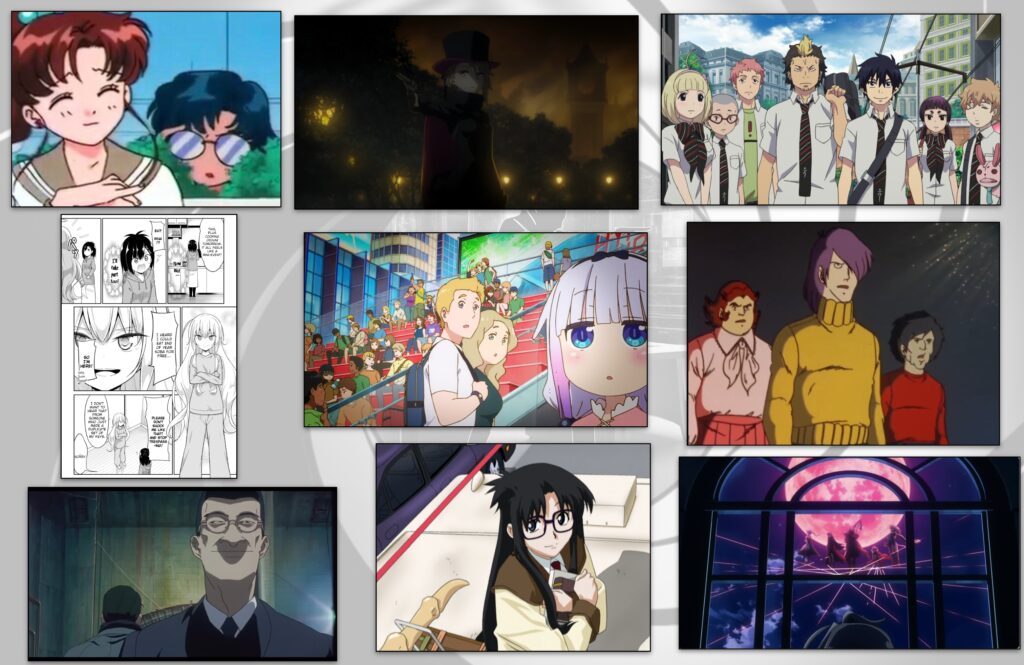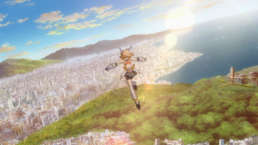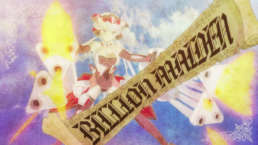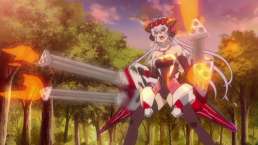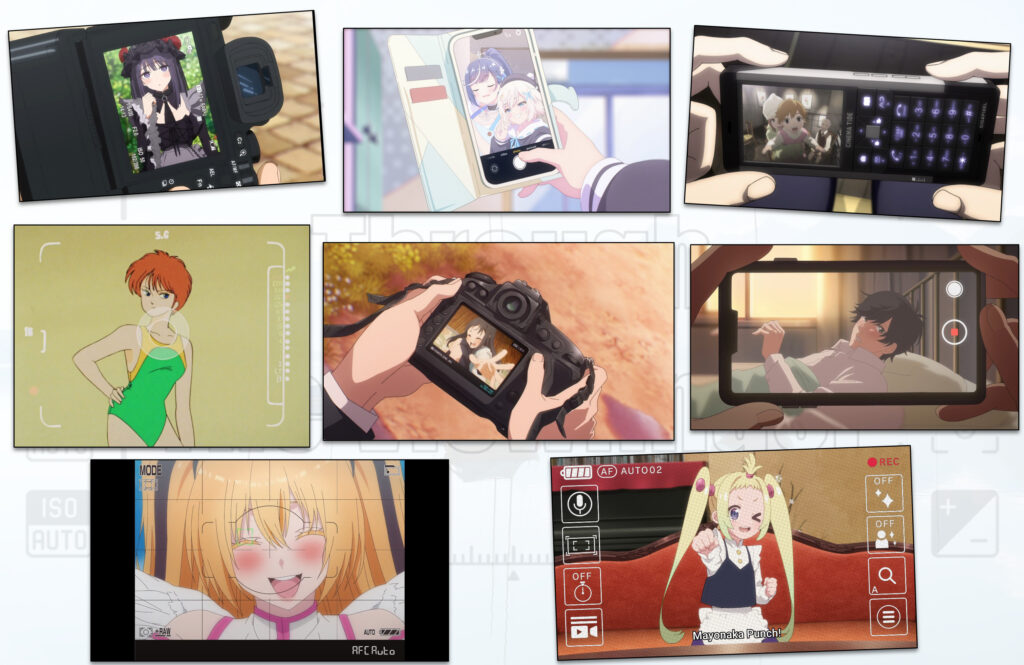AniManga Picture Challenge Week 11: New Worlds
This week on the #AniMangaFoundIt #AniMangaPictureChallenge, we explored New Worlds across #anime and #manga!
My Little Ponfarr - Bofuri: I Don't Want to Get Hurt, so I'll Max Out My Defense
socks - Serial Experiments Lain
Kafkaz - The Boy and the Heron
hexer_class - Show By Rock
Ragashingo - Flip Flappers
chikorita157 - I've Been Killing Slimes for 300 Years and Maxed Out My Level
Tatsumeg - Call of the Night
Anicast - RahXephon
CT - Space Brothers
Retro Goth Bunny - The Apothecary Diaries

AniManga Picture Challenge Week 10: Favorite Spaceships
Week 10 of the #AniMangaPictureChallenge is complete! Big thanks to everyone who detected their Favorite #anime and #manga spaceships!
UkeBLCatboy - Battleship Yamato ;)
My Little Ponfarr - Battle of the Planets? G-Force: Guardians of Space? Science Ninja Team Gatchaman? :p
chikorita157 - Stardust Telepath
Anicast - Kiddy Grade
Mole- Keep Your Hands Off Eizouken!
Ragashingo - Macross Frontier
Tatsumeg - Astra Lost in Space
socks - Planetes

AniManga Picture Challenge Week 9 - Spies
For week 9 of the #AniMangaFoundIt #AniMangaPictureChallenge we spied some Spies!
that's winter! - Sailor Moon
My Little Ponfarr - Miss Kobayashi's Dragon Maid
Ragashingo - Princess Principal
Kafkaz - Blue Exorcist: Shimane Illuminati Saga
Retro Goth Bunny - Gabriel DropOut
Tatsumeg - Akame ga Kill!
CT - Super Dimension Fortress Macross
socks - Patlabor 2
Anicast - Read Or Die
Symphogear Episode 08: No Shadows in the Sunlight
Episode Summary:
 In the aftermath of Miku’s big reveal that she could no longer stand being friends with Hibiki, she and Hibiki are now sleeping in separate beds. And neither is happy about it. Miku gets up early and heads out without Hibiki in a further sign of the cracks in their friendship. Chris, too, is still feeling the effects of her own sort of falling out. She is still on the run from Finè and still being chased by a handful of Noise. She defeats a final bunch of them, but then collapses in an alleyway where she is found by Miku.
In the aftermath of Miku’s big reveal that she could no longer stand being friends with Hibiki, she and Hibiki are now sleeping in separate beds. And neither is happy about it. Miku gets up early and heads out without Hibiki in a further sign of the cracks in their friendship. Chris, too, is still feeling the effects of her own sort of falling out. She is still on the run from Finè and still being chased by a handful of Noise. She defeats a final bunch of them, but then collapses in an alleyway where she is found by Miku.
Somehow Miku gets the unconscious Chris to safety and takes care of her all morning along with the lady from the Flower restaurant. Together, the two nurse her wounds and clean her clothes. Chris is pretty beaten and bruised despite being a Symphogear user.
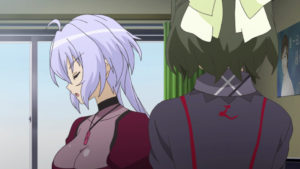 Here, we get twin talks between Miku and Chris, and Hibiki and Tsubasa. On the roof of their school, Hibiki laments to Tsubasa how she is upset because despite now being a superhero, she still has the most trouble solving the small important things like friendship. When Tsubasa begins talking about how lucky she is to have survived singing her superb song, Hibiki ends up comforting her. She reminds Tsubasa that she was there at her and Kanade’s final concert, so she knows Tsubasa’s songs are useful for more than just destruction.
Here, we get twin talks between Miku and Chris, and Hibiki and Tsubasa. On the roof of their school, Hibiki laments to Tsubasa how she is upset because despite now being a superhero, she still has the most trouble solving the small important things like friendship. When Tsubasa begins talking about how lucky she is to have survived singing her superb song, Hibiki ends up comforting her. She reminds Tsubasa that she was there at her and Kanade’s final concert, so she knows Tsubasa’s songs are useful for more than just destruction.
Meanwhile, we learn Chris’ full backstory. Her parents were killed and she was kidnapped and probably had all manner of abuses and terrible things done to her. Then, after she was rescued from that, Finè stole her away and misled and abused her further. “All adults are trash!” Chris concludes. She then gives Miku a tip on how to deal with her split from Hibiki. Just beat her up and make it clear who is stronger. Then you can make up. Miku doesn’t want to do that, and can’t anyway, but she still thanks Chris for worrying about her. Miku tells Chris she wants them to become friends.
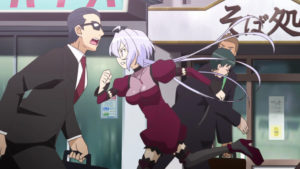 About this time, a Noise alert sounds and people go running for shelters. Chris doesn’t recognize the warnings at first, but once she’s told what they are, she goes running towards the danger! Chris laments that a lot of the Noise problem is her fault and that her attempts to bring peace only caused more harm, but she still stands up and takes on the Noise, demanding they focus on her and leaves others out of it. But, when Chris has trouble transforming into her Symphogear, Genjuro is there to save her. Chris completes her transformation and goes to town on the Noise telling Genjuro to go save others.
About this time, a Noise alert sounds and people go running for shelters. Chris doesn’t recognize the warnings at first, but once she’s told what they are, she goes running towards the danger! Chris laments that a lot of the Noise problem is her fault and that her attempts to bring peace only caused more harm, but she still stands up and takes on the Noise, demanding they focus on her and leaves others out of it. But, when Chris has trouble transforming into her Symphogear, Genjuro is there to save her. Chris completes her transformation and goes to town on the Noise telling Genjuro to go save others.
Meanwhile, Hibiki finds Miku and the restaurant owner trapped in a damaged building. A strange octopus Noise that responds to sound is overhead, so Miku communicates with Hibiki by writing messages on her phone. Miku silently shares her plan to lure the Noise away and tells Hibiki she trust her to save her before yelling out to attract the Noise and sprinting off to give Hibiki time to transform. Miku runs and runs and is almost caught by the Noise, but manages to dodge just in time which allows Hibiki to save her.
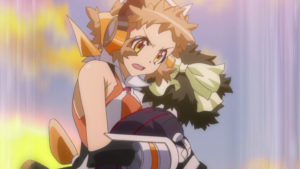 Hibiki, for her part, finally understands why she fights so hard to save others. It’s not because she is guilty at having survived the Noise attack at the concert. It’s because she was inspired by Kanade and wants to carry her acts of saving people forward into the future in Kanade’s place. Hibiki rescues Miku and the two are finally able to make up.
Hibiki, for her part, finally understands why she fights so hard to save others. It’s not because she is guilty at having survived the Noise attack at the concert. It’s because she was inspired by Kanade and wants to carry her acts of saving people forward into the future in Kanade’s place. Hibiki rescues Miku and the two are finally able to make up.
Chris is still out there alone. She’s had quite the day, but it included making a friend and being helped by an adult. She walks off in silence contemplating everything that happened.
Episode Impressions:
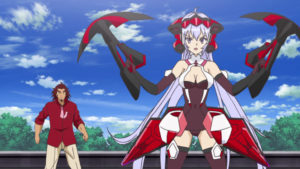 This episode feels like it follows up on, advances, and concludes a few minor plot threads in preparation of more to come. Hibiki and Miku’s trouble are finally solved. And although Chris is still on her own, it feels like she is beginning to learn that maybe there are people she can trust. We still have Tsubasa not yet cleared to fight, but even she was encouraged that her songs can be for more than destruction.
This episode feels like it follows up on, advances, and concludes a few minor plot threads in preparation of more to come. Hibiki and Miku’s trouble are finally solved. And although Chris is still on her own, it feels like she is beginning to learn that maybe there are people she can trust. We still have Tsubasa not yet cleared to fight, but even she was encouraged that her songs can be for more than destruction.
All in all, while there are moments I enjoyed in this episode, it does feel like it’s caught in between. Things do happen. Problems are solved. But it really feels like bigger things are yet to come. It’s not a bad episode by any means. But, it’s also not really a key episode…
Specific Scenes I Loved:
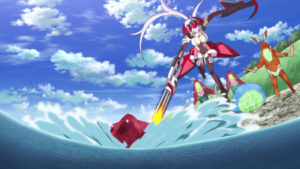 Chris running to stop the dangers that she would have played a role in causing only a few days before. The part a little later where she stands up and demands the Noise attack her is pretty awesome. She’s mad as hell at her own failures but also at the Noise going after those who can’t fight.
Chris running to stop the dangers that she would have played a role in causing only a few days before. The part a little later where she stands up and demands the Noise attack her is pretty awesome. She’s mad as hell at her own failures but also at the Noise going after those who can’t fight.
I also really enjoyed the fact that Chris trusted Genjuro to go save others. It’s a tiny thing, but the girl who just a few minutes ago said “all adults are trash” told an adult she trusted him. It’s not the most direct admission in the world, but Chris is slowly opening up.
Hibiki realizing why she truly fights. It was never about guilt for her. It was about being inspired by Kanade and helping continue her actions echoing out into the future.
It’s short and the combat animation isn’t really all that great, but I still loved Chris’ little war against the Noise.
Songs In This Episode:
Makyuu Ichaival – Chris’ song returns, but now it is focused on the Noise. That part where she sings that she’s gonna blow you and you and you and you to pieces is pretty awesome.
Watashi to Iu Oto Hibiki Sono Saki ni (The Sound Called Me Resonates Beyond) – The messages of this song resonate in an awesome way here. Right as Hibiki is having her revelation that she helps people to continue Kanade’s goals, she is also singing: “But now at least I understand one thing. For someone else’s sake people can get stronger.” It’s a nice sync up of thoughts and lyrics in that moment.
Themes In This Episode:
 Along with realizing why she truly helps people, Hibiki now also understands that you can’t save anyone on your own. That people need to want to be saved and need to help save themselves. Kanade telling her “Don’t give up living!” now fully registers with Hibiki.
Along with realizing why she truly helps people, Hibiki now also understands that you can’t save anyone on your own. That people need to want to be saved and need to help save themselves. Kanade telling her “Don’t give up living!” now fully registers with Hibiki.
Chris is in a troubled place where a lot of her preconceived notions are being challenged by better, more pure ideals… but at least for now she is still clinging to her idea of using strength and violence as a way to conquer others’ bad actions. She’s applying her philosophy to arguments between friends rather than world peace, this time, but it’s the same core concept.
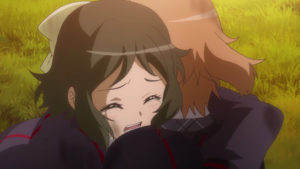 We get a sorta inversion of Hibiki’s thought that people can understand each other if they talk and work out their problems. Miku goes through most of this episode, and the last, not talking to Hibiki. This leaves the two of them at odds. Then, at the end, Miku reveals what really drove her away from Hibiki. It wasn’t so much the secrets that Hibiki was keeping. It was that Hibiki was shouldering a dangerous burden alone. It hurt Miku that Hibiki wasn’t sharing the burden and it scared Miku to think that Hibiki might be hurt or killed by the heroics she was undertaking. But, once the two started talking about it again, things got much better between them!
We get a sorta inversion of Hibiki’s thought that people can understand each other if they talk and work out their problems. Miku goes through most of this episode, and the last, not talking to Hibiki. This leaves the two of them at odds. Then, at the end, Miku reveals what really drove her away from Hibiki. It wasn’t so much the secrets that Hibiki was keeping. It was that Hibiki was shouldering a dangerous burden alone. It hurt Miku that Hibiki wasn’t sharing the burden and it scared Miku to think that Hibiki might be hurt or killed by the heroics she was undertaking. But, once the two started talking about it again, things got much better between them!
On the roof with Tsubasa, Hibiki is sad that even as a Symphogear wearing superhero, she can’t just solve the little (huge) issue of her estranged friendship with Miku.
Special Attacks In This Episode:
Things You Should Pay Attention To:
Chris. Though she never admits it directly, she is changing for the better. She cares about Miku’s strained friendship even if she offers highly questionable advice on how to mend things. She runs towards danger to end it rather than causing that same danger herself. She doesn’t exactly accept Genjuro’s help, but she does instruct him to help others. She is still very troubled, and very unsure of where her priorities lie, but Chris is no longer the villainess she was in earlier episodes.
Moment By Moment Notes:
0:11 – In the aftermath of their argument, Miku is sleeping alone on the bottom bunk
0:49 – Chris is still being chased by noise
2:48 – So that Chris v Noise encounter happened early in the morning
3:00 – A Place to call Home Chris has nowhere to go home to?
3:48 – Miku rescued Chris
4:43 – So… Miku took Chris to the Flower lady’s home instead of a hospital??
4:54 – Chris is pretty beat up. I guess the Symphogear doesn’t fully protect you from all injuries…
5:24 – Miku never skips school
5:47 – The small things that truly matter are hard to do even for a superhero
7:02 – Tsubasa’s songs aren’t just for destruction. They are also songs of hope.
7:41 – Chris has no friends.
7:44 – We hear Chris’ backstory. Her parents were killed and she was kidnapped and used and abused for years before being rescued. But then Finè stole her away and used her more…
8:24 – Chris still believes the way to solve things is by being stronger and using force to end conflict. A bit of a variation on Chris’ Wish
8:48 – Once again, we see that Chris does have an inclination to care for people.
9:10 – Chris now has a friend!
10:03 – Chris does not recognize the Noise alert. Probably because she’s been the cause of such things and has never been on the receiving end!
10:15 Chris runs towards the danger.
11:07 – “I’m right here! So leave others the hell out of this!” Pretty chilling words.
11:30 – Genjuro is still an improbable badass.
12:22 – In contrast with her “Adults are all trash” stance earlier, Chris has come to trust Genjuro to be someone who saves people, even if she herself doesn’t really realize it!
12:48 – Though it’s not framed super well, there’s some cool bits to the way Chris fights here. She even kills a Noise as it tries to surprise her by coming out of the water.
13:33 – Nice jump flip by Hibiki
13:53 – Nice idea by Miku to communicate by phone screen when the Noise goes after sound.
14:15 – So we don’t get to see what they say?
14:55 – Miku feels sorry for the things she said and wants to fight too.
15:06 – Miku is a track runner…
15:59 – Now we get to see what was said. Miku shares the plan to lure the Noise away. Miku trusting Hibiki with her life is powerful!
16:53 – Don’t Give Up Living – Everyone is giving it their all, but you can’t save anyone with your own strength… they have to participate and help in being saved.
17:17 – It’s not guilt that makes Hibiki want to save others, it’s because she is carrying on Kanade’s dream in her place. (Also, the music lyrics sync up really well here: “But now at least I understand one thing. For someone else’s sake people can get stronger.)
18:04 – That’s one heck of a punch!
18:13 – “I am the sound that echoes ahead” – great lyrics
18:27 – They animated some gently moving ducks instead of the complex bouncing of two main characters from a long fall. 😛
19:23 – I wasn’t mad you kept secrets from me, I was mad that you tried to shoulder all that burden by yourself. I was just being selfish because I didn’t want to lose you again.
20:22 – A new picture!
21:50 – Chris survived.
22:08 – And things are good between Hibiki and Miku again.
AniManga Picture Challenge Week 8 - Fall
Week 8 of the #AniMangaFoundIt #AniMangaPictureChallenge is complete. And a cozy week it was as we explored the colors and temps of Fall in #anime.
My Little Ponfarr - SuperCub
Anicast - Your Lie In April
Ragashingo - 86 Eighty-Six
chikorita157 - Slow Loop
socks - Yuru Camp
Tatsumeg - Spice & Wolf (2008)
LiteralGrill - Weird Volunteers
Thanks to everyone who participated!

AniManga Picture Challenge Week 7 - Pirates
Week 7 of the #AniMangaPictureChallenge is complete! Thanks to everybody who came up with a surprisingly cute collection of #anime and #manga Pirates!
My Little Ponfarr - Doraemon the Movie: Nobita's Great Adventure in the South Seas
chikorita157 - Kiniro Mosaic
Ragashingo - Gargantia on the Verdurous Planet
Jitsch - Suite PreCure
CT - Space Brothers
socks - Space Pirate Mito
Anicast - Space Patrol Luluco
hexer_class - Bang Dream!
Tatsumeg - Bodacious Space Pirates
Symphogear Episode 07: Fate Just Keeps Firing
Episode Summary:
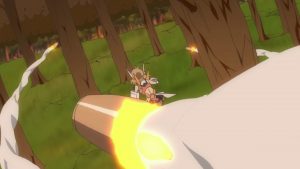 After the briefest of recaps, where Miku again worries about Hibiki, we jump right back into the action of Chris vs Hibiki. We learn that Hibiki’s punch from the end of the last episode packed nearly as much power as Tsubasa’s superb song. Chris’ armor is even struggling to regenerate after taking the single hit. Chris and Hibiki trade a couple more blows before Chris realizes she isn’t getting anywhere. The Nehushtan armor isn’t powerful enough to defeat Hibiki. But Chris has another surprise in store. She explosively ditches the Nehushtan armor and then sings out in the familiar chant of someone activating a symphogear. When the dust clears, we find that Chris somehow has Ichi-bal, a relic stolen from second division some ten years before.
After the briefest of recaps, where Miku again worries about Hibiki, we jump right back into the action of Chris vs Hibiki. We learn that Hibiki’s punch from the end of the last episode packed nearly as much power as Tsubasa’s superb song. Chris’ armor is even struggling to regenerate after taking the single hit. Chris and Hibiki trade a couple more blows before Chris realizes she isn’t getting anywhere. The Nehushtan armor isn’t powerful enough to defeat Hibiki. But Chris has another surprise in store. She explosively ditches the Nehushtan armor and then sings out in the familiar chant of someone activating a symphogear. When the dust clears, we find that Chris somehow has Ichi-bal, a relic stolen from second division some ten years before.
After complaining that she hates singing, Chris breaks out into a harsh set of rock lyrics as she unleashes a rather awe inspiring wave of firepower at Hibiki. All Hibiki can do is run as Chris opens fire with energy crossbows, giant twined double gattling guns, and racks full of micro missiles. But, as the explosions fade, Chris is surprised to find that her attacks were blocked by a large wall of silver and blue metal. “A shield?” she wonders. “A sword.” Tsubasa answers from out of nowhere, standing heroically atop one of her giant Heaven’s Wrath blades. Tsubasa then looks back to the recovering Hibiki and says the words we thought we might never hear. “I need your help.”
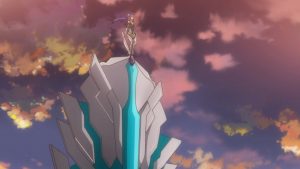 Tsubasa leaps down and confronts Chris in close combat, but a flight of Noise attack before she and Hibiki can subdue the troubled girl. Except, they don’t go after Hibiki or Tsubasa this time. Instead, they target a surprised Chris who is only saved thanks to Hibiki’s reckless interference. And here, for the first time in the open, is Finè. She tells Chris she has no further use for her then collects the pieces of the discarded Nehushtan armor and leaves with a distraught Chis chasing after her. Back at Second Division headquarters, we learn that Chris Yukine is a girl who went missing two years ago after having been rescued from a war in South America.
Tsubasa leaps down and confronts Chris in close combat, but a flight of Noise attack before she and Hibiki can subdue the troubled girl. Except, they don’t go after Hibiki or Tsubasa this time. Instead, they target a surprised Chris who is only saved thanks to Hibiki’s reckless interference. And here, for the first time in the open, is Finè. She tells Chris she has no further use for her then collects the pieces of the discarded Nehushtan armor and leaves with a distraught Chis chasing after her. Back at Second Division headquarters, we learn that Chris Yukine is a girl who went missing two years ago after having been rescued from a war in South America.
Tsubasa returns to Second Division for the first time since her nearly fatal superb song. While it’s clear that she is still struggling with moving on from Kanade’s death, she is now at least willing to put in the effort to help Hibiki out as a partner instead of an unwelcome replacement.
 Hibiki returns to her dorm room where Miku is waiting for her. Miku isn’t just angry with her. She is cold towards Hibiki and is barely willing to talk to her at all. After one short, angry outburst, Miku goes to bed… but chooses to use the normally unused bottom bunk. Things are not looking good at all between Hibiki and Miku.
Hibiki returns to her dorm room where Miku is waiting for her. Miku isn’t just angry with her. She is cold towards Hibiki and is barely willing to talk to her at all. After one short, angry outburst, Miku goes to bed… but chooses to use the normally unused bottom bunk. Things are not looking good at all between Hibiki and Miku.
We then turn to Chris who has apparently been wandering alone through the city all evening. She’s struggling with Hibiki’s claim that people can learn to understand each other if they are just willing to talk. Chris comes across a young brother and sister who have become separated from their father. Surprisingly, Chris helps the pair look for their parent and at one point the little girl she is escorting catches her humming a little tune. But, when asked about it, Chris again states that she hates singing. The three find the children’s father who thanks Chris for her help. When Chris asks the kids how they can get along so well, they tell her sometimes they don’t. But, after they fight they make up and get along again. This seems to give Chris something new to think about.
 That night, we see Ryoko dictating some notes to herself about the capabilities and limitations of the Symphogear system. She starts by talking about the things we know about them: That they empower their users but can end up killing them especially when their users use the superb song ultimate attack. She goes on to talk about how Hibiki may be the one Symphogear users who can resist the dangers of the Symphogear thanks to being a fusion of a normal human and a relic. And how this unique fusion even let Hibiki activate Durandal. But, then Ryoko beings talking about how Hibiki could be the proof that humanity is breaking free of some kind of ancient curse put on it by “The Custodians” and might be able to regain control of its fate.
That night, we see Ryoko dictating some notes to herself about the capabilities and limitations of the Symphogear system. She starts by talking about the things we know about them: That they empower their users but can end up killing them especially when their users use the superb song ultimate attack. She goes on to talk about how Hibiki may be the one Symphogear users who can resist the dangers of the Symphogear thanks to being a fusion of a normal human and a relic. And how this unique fusion even let Hibiki activate Durandal. But, then Ryoko beings talking about how Hibiki could be the proof that humanity is breaking free of some kind of ancient curse put on it by “The Custodians” and might be able to regain control of its fate.
 Back at school, Miku is still not talking to Hibiki. When the two’s friends try to help, Miku runs off. When Hibiki catches up to her, Miku apologizes for the way she has been acting, but it’s not a real apology. Instead, Miku tells Hibiki she was so hurt by Hibiki’s actions that she doesn’t think they can remain friends any longer and departs leaving a devasted Hibiki alone on the school roof.
Back at school, Miku is still not talking to Hibiki. When the two’s friends try to help, Miku runs off. When Hibiki catches up to her, Miku apologizes for the way she has been acting, but it’s not a real apology. Instead, Miku tells Hibiki she was so hurt by Hibiki’s actions that she doesn’t think they can remain friends any longer and departs leaving a devasted Hibiki alone on the school roof.
Finally, at the very end, we see Chris return to Finè only to be completely betrayed. Not only does Finè deploy noise to attack Chris, she cruelly attacks Chris’ worldview of using power to stop the powerful from waging war. Chris makes a run for it, but it is unclear whether she will survive!
Episode Impressions:
 I liked this episode a lot. Not only did we get a cool fight sequence with Chris showing her true power, we also got to see the show start to pay off several of the story threads it has been setting up. We got a big turning point for Tsubasa, a big change in Hibiki and Miku’s strained friendship, and I think we’re beginning to see Chris question her own past actions.
I liked this episode a lot. Not only did we get a cool fight sequence with Chris showing her true power, we also got to see the show start to pay off several of the story threads it has been setting up. We got a big turning point for Tsubasa, a big change in Hibiki and Miku’s strained friendship, and I think we’re beginning to see Chris question her own past actions.
This is where I was hoping the show would start to go after building and building the tension between characters for the past several episodes.
Specific Scenes I Loved:
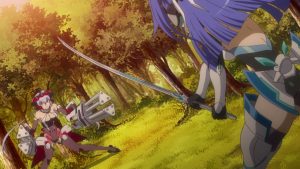 Chris’s rock/metal Symphogear attack names. Billion Maiden? Mega Death Party? It seems like all of Chris’ attacks are partially named after famous bands. Plus, they look awesome. Those quad miniguns are especially cool!
Chris’s rock/metal Symphogear attack names. Billion Maiden? Mega Death Party? It seems like all of Chris’ attacks are partially named after famous bands. Plus, they look awesome. Those quad miniguns are especially cool!
Tsubasa finally admitting that she needs Hibiki’s help. This one has been a long time coming! Along with it was Tsubasa’s acknowledgement that Chris needed to be treated as something other than an enemy. That trying to kill her was not the correct strategy. By relaxing her rage, Tsubasa was able to fight better and see things clearer.
Getting to see a non-evil side of Chris. She was conflicted and confused after her fight with Hibiki, but she still took it upon herself to help some lost kids find their dad. Chris seems to be something of a kind, decent person when she is apart from Finè.
Songs In This Episode:
Makyuu Ichaival (Ichaival, the Magic Bow) – Where Hibiki’s songs have been mostly about hope and moving forward, and Tsubasa’s has been about her grief giving her power, Chris’ song is much more harsh and is filled with despair and anger. She sings about ripping out her proverbial wounds in order to forget her past. She sings about how she is someone who can’t be relied on. She sings about how she can’t trust adults and how she has never known their love. At one points she sings something like: “How can you believe in adults like that? I have never never never never known their love!” Yes, this is a song of anger and mistrust and anguish. There’s a thin sliver of a wish to be loved buried in there, but it is almost entirely drowned out by the rest of the lyrics.
Watashi to Iu Oto Hibiki Sono Saki ni (The Sound Called Me Resonates Beyond) – We continue this song at the beginning of the episode, but it soon gives way to Chris’. Nothing new here, I don’t think.
Zettō Ame no Habakiri (Ame no Habakiri, the Ultimate Blade) – Same with Tsubasa’s song. Nothing new. But, wow, it sure was nice hearing it start up as we saw Tsubasa had saved the day!
Themes In This Episode:
 Similar to the end of last episode, we again see Hibiki attempt to talk to Chris rather than fight her. We aren’t noise, we can talk and so we can understand each other, Hibiki reasons. It’s a very interesting mindset when it seems like Hibiki could defeat Chris in battle if she just kept at it. But, Hibiki’s goal isn’t to defeat Chris, it is to help Chris even as they fight.
Similar to the end of last episode, we again see Hibiki attempt to talk to Chris rather than fight her. We aren’t noise, we can talk and so we can understand each other, Hibiki reasons. It’s a very interesting mindset when it seems like Hibiki could defeat Chris in battle if she just kept at it. But, Hibiki’s goal isn’t to defeat Chris, it is to help Chris even as they fight.
Tsubasa’s homecoming to Second Division is pretty neat. She is now able to think back fondly to Kanade’s words about being flexible like reeds that bend against a strong wind. Her friend’s encouragement even jumps into her mind as Tsubasa continues to struggle a bit with finding her own way beyond the fighting. What was it that Tsubasa used to love doing?
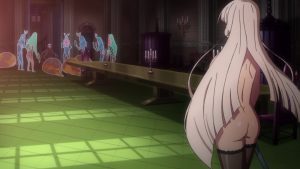 We again hear a bit about Chris’ true goals. She yells to Finè that she can extinguish the flames of war on her own with her own strength. We know Chris is being heavily used and manipulated. Has Finè tricked Chris into thinking she can put a stop to wars through violence? Finè pretty much confirms this at the end when she tells Chris that trying to stop war with violence is foolish because it will just spark more war. We heard through Chris’ song how angry and hurt she is… but she is still someone trying to prevent war? I think we’re being shown that there is more to Chris than just being an evil lackey for Finè.
We again hear a bit about Chris’ true goals. She yells to Finè that she can extinguish the flames of war on her own with her own strength. We know Chris is being heavily used and manipulated. Has Finè tricked Chris into thinking she can put a stop to wars through violence? Finè pretty much confirms this at the end when she tells Chris that trying to stop war with violence is foolish because it will just spark more war. We heard through Chris’ song how angry and hurt she is… but she is still someone trying to prevent war? I think we’re being shown that there is more to Chris than just being an evil lackey for Finè.
Special Attacks In This Episode:
Things You Should Pay Attention To:
Both Finè and Ryoko Sakrui really like their butterflies.
Chris claims to hate singing, but she hums her little song. We only get to hear a few seconds of that tune, but try to keep it in mind. It will come back at some point.
Moment By Moment Notes:
2:01 – Hibiki’s punch was almost as powerful as Tsubasa’s Superb Song?!
2:05 – The Nehushtan armor is repairing itself? Looks painful. Is it drawing on Chris’ life force to do so?
2:32 – We can understand each other if we talk
2:56 – It’s hard to tell, but I think Hibiki accidentally hit Chris as she dodged and redamaged Chris’ armor!
3:10 – A Symphogear transformation song?!
3:26 – Yep, a Symphogear named Ichii-Bal.
3:32 – So this is the other relic that was mentioned as having been lost in a previous episode…
3:52 – Chris hates singing?!
4:07 – Billion Maiden
4:15 – Mega Death Party
4:30 – Unleashing all that firepower tired Chris out.
4:42 – A shield? A sword!
4:52 – Chris is very perceptive here. And who did she hear Tsubasa’s private thoughts from??
5:13 – I need your help. (Wow! Now there’s some character growth!)
6:27 – So Finè finally shows herself to the others!
6:35 – Chris’ entire mission was to capture Hibiki, yet she threw Hibiki aside! And Chris’ real goal is to extinguish the flames of war??
6:39 – What curse on humanity is Chris talking about?
7:44 – Is she the one mentioned in the newspaper as having vanished way back in the first episode? Probably.
8:13 – How about being more human again? Wouldn’t that work?
8:54 – What did Tsubasa love to do a long time ago? Sing on stage?
10:22 – Tsubasa called Hibiki a comrade!
12:30 – Crush every human with the will and power to fight.
14:00 – Chris again says she hates singing. But she was humming a tune for a while there.
15:06 – Miku is sleeping in the bottom bunk now. That’s different.
16:16 – She sure does like her butterflies
16:26 – Hibiki might be able to sing her Superb Song without dying? Because she is fusing with a Relic?
17:15 Custodian’s Curse? Is this the first we’ve heard of that? Is this the cruse Chris mentioned??
19:44 – I don’t think I can be your friend anymore.
20:12 – Credits already?!
22:22 – And now Finè turns on Chris and Chris is alone!
22:35 – And Finè knows Chris never had the ability to stop all war!
23:08 – Kadingir?
23:37 – Is Chris going to die??
AniManga Picture Challenge Week 6 - Through the Viewfinder
Week 6 of the #AniMangaPictureChallenge is complete! Big thanks to Mole for the suggestion of Through The Viewfinder! And to everyone who participated in this #anime and #manga challenge.
My Little Ponfarr - My Dress-up Darling
Rei - Mayonaka Punch
Tatsumeg - Akebi's Sailor Uniform
chikorita157 - VTuber Legend
Ragashingo - Time of Eve
Mole - Twilight out of Focus
CT - Kimagure Orange Road
Anicast - 2.5 Dimensional Seduction
Symphogear Episode 06: Where Omens Lead
Episode Summary:
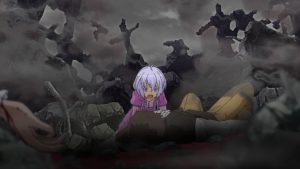 We start this episode off from Chris’ point of view. We find out that something really bad happened to her when she was a child. There was an explosion or attack that seemed to have killed her parents. Then Chris appears to have been captured and maybe even put into slavery / human trafficking! And, somehow, Finé, the woman who is using and abusing Chris, must have taken her in. But now, Finé is after Hibiki, and Chris is afraid Finé will abandon her and she will be alone again if she doesn’t capture the new Symphogear user. Chris says she can get the job done but she wants to use her own power, not the power of the Noise and Solomon’s Cane.
We start this episode off from Chris’ point of view. We find out that something really bad happened to her when she was a child. There was an explosion or attack that seemed to have killed her parents. Then Chris appears to have been captured and maybe even put into slavery / human trafficking! And, somehow, Finé, the woman who is using and abusing Chris, must have taken her in. But now, Finé is after Hibiki, and Chris is afraid Finé will abandon her and she will be alone again if she doesn’t capture the new Symphogear user. Chris says she can get the job done but she wants to use her own power, not the power of the Noise and Solomon’s Cane.
Back at the hospital, Tsubasa is starting to recover from her near death experience. She is up and walking again. It also seems that her revelation about looking beyond the need to fight stuck with her outside of her dream.
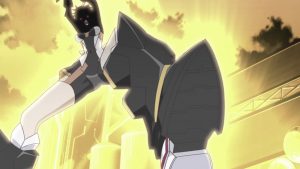 Hibiki is doing some reflecting, too. She is worried about how easily she attacked Chris with Durandal’s power. She and Miku share a moment where Miku notes how buff Hibiki is getting after their post run bath. The two plan to go to lunch later.
Hibiki is doing some reflecting, too. She is worried about how easily she attacked Chris with Durandal’s power. She and Miku share a moment where Miku notes how buff Hibiki is getting after their post run bath. The two plan to go to lunch later.
Back at headquarters, there is a lot of discussion about the defense minister’s death. In some ways, it is a setback because he was friendly to 2nd Division, but in others, he often shielded them from scrutiny, but that also meant they couldn’t get the funding they needed. The new defense minister seems more willing to fund 2nd Division, but in return their activities will be more closely watched. Interestingly, the new defense minister is more closely allied with the Americans.
 Later, Ogawa calls Hibiki and ask her to check in on Tsubasa. This again puts Hibiki at odds with Miku who wanted them to spend time together. When Hibiki makes it to Tsubasa’s hospital room she finds it a complete mess. Turns out it was Ogawa who usually cleaned it up for Tsubasa… much to Tsubasa’s embarrassment.
Later, Ogawa calls Hibiki and ask her to check in on Tsubasa. This again puts Hibiki at odds with Miku who wanted them to spend time together. When Hibiki makes it to Tsubasa’s hospital room she finds it a complete mess. Turns out it was Ogawa who usually cleaned it up for Tsubasa… much to Tsubasa’s embarrassment.
Hibiki and Tsubasa talk in Tsubasa room and on the roof of the hospital. They talk about why they fight as Symphogear users. For Hibiki, it’s something that she laughs off, but eventually she admits that it’s because Kanade saved her two years ago. For Tusbasa, it almost seems like she is trying to help people but while looking for a way to die. To escape the pain of everything and everyone she’s lost.
 Hibiki comes away from their talk encouraged and heads off to Flowers restaurant to meet with Miku. She sees Miku along the way but Chris suddenly appears and attacks, forcing Hibiki to transform in front of Miku in order to save her. With barely an apology, Hibiki rushes off to try and stop Chris, leaving Miku behind to worry about their battle.
Hibiki comes away from their talk encouraged and heads off to Flowers restaurant to meet with Miku. She sees Miku along the way but Chris suddenly appears and attacks, forcing Hibiki to transform in front of Miku in order to save her. With barely an apology, Hibiki rushes off to try and stop Chris, leaving Miku behind to worry about their battle.
Episode Impressions:
 This episode was a little exposition heavy, but that’s not all bad. The talk between Tsubasa and Hibiki appears to show that Tsubasa has finally begun to accept Hibiki as a Symphogear user. That Tusbasa is now trying to help Hibiki, if only to help her avoid falling into the unhappy life of a warrior, is something new. That’s a pretty big turning point for Tusbasa, even if she might not be fully supporting Hibiki yet.
This episode was a little exposition heavy, but that’s not all bad. The talk between Tsubasa and Hibiki appears to show that Tsubasa has finally begun to accept Hibiki as a Symphogear user. That Tusbasa is now trying to help Hibiki, if only to help her avoid falling into the unhappy life of a warrior, is something new. That’s a pretty big turning point for Tusbasa, even if she might not be fully supporting Hibiki yet.
If anything, I think this is another one of those episodes that did the necessary work of setting up that our characters are changing. Hibiki is now able to admit why she fights. Tusbasa is now looking beyond the fighting. Even Chris now has a real reason for why she fights, even if we don’t know all of it yet. If the next episode starts paying off these changes then we’ll be in a good place.
Specific Scenes I Loved:
 Hibiki declaration of what she wants to do when she sees someone in trouble. Moving as quickly, shortly, and directly as possible to help people is pretty much what Hibiki is all about!
Hibiki declaration of what she wants to do when she sees someone in trouble. Moving as quickly, shortly, and directly as possible to help people is pretty much what Hibiki is all about!
Hibiki’s battle with Chris. Hibiki is doing as well or perhaps even better than battle hardened Tsubasa at this point in the battle. We’ll have to see if that holds up next episode.
Songs In This Episode:
Watashi to Iu Oto Hibiki Sono Saki ni (The Sound Called Me Resonates Beyond) – Now here is an interesting song! Interesting because we’ve both have and haven’t heard it before! This is Hibiki singing her version of Kanade’s final song! This new version is definitely Hibiki’s. It is much more hopeful, even as Hibiki sings about her own stumbles. The key difference between the two is that where Kanade sung:
We might have met in order to not forget the light
The sound called ‘you’ plays until it burns out
I am by your side, so sing out with us
Hibiki instead sings:
Maybe that’s why we were brought together
The sound called me resonates beyond
Sing your kindness, sing out with us
It gives me chills thinking about how Hibiki is the echo that rippled out beyond the end of Kanade’s life! Pretty cool then that “Hibiki” means “Echo” among other things in Japanese. Kanade burnt out her life to save Hibiki, now Hibiki is able to embrace her life and save many, many others.
Themes In This Episode:
This episode is fairly theme heavy even though not a ton really happened:
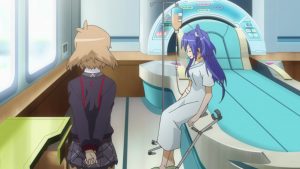 – We return to the theme of self sacrifice. Tusbasa is pretty insistent that Hibiki not fight just to find a way to hide the guilt and pain that comes with losing people. It’s unspoken, but Tsubasa is very clearly talking about herself. She felt it was her duty to endlessly fight and fight. To protect people. But really, she was fighting knowing… hoping even… that she would come across a battle that would be too much for her so that she could die and be free of her pains of loss. Tsubasa was too proud to break down and admit her feelings, so dying honorably against an overwhelming enemy force was her only hope of ending the grief she felt over Kanade’s death.
– We return to the theme of self sacrifice. Tusbasa is pretty insistent that Hibiki not fight just to find a way to hide the guilt and pain that comes with losing people. It’s unspoken, but Tsubasa is very clearly talking about herself. She felt it was her duty to endlessly fight and fight. To protect people. But really, she was fighting knowing… hoping even… that she would come across a battle that would be too much for her so that she could die and be free of her pains of loss. Tsubasa was too proud to break down and admit her feelings, so dying honorably against an overwhelming enemy force was her only hope of ending the grief she felt over Kanade’s death.
– But, we also have some small indications that Tsubasa is looking for the world beyond fighting. Tsubasa’s near death does seem to have changed her outlook on the world. I think she is just barely understanding that herself, but I’m hopeful that she’ll continue to move forward with her life. She’s been stuck as nothing but a warrior and “sword” for so long, it’s nice that she might see herself as a person soon.
 – We finally hear more about why Hibiki really want to help people. Previously she said it was so she could return to her own normal life. But now, we go deeper and learn that Hibiki feels a responsibility to Kanade. Hibiki knows she should have died at the concert two years before, so she wants to justify her survival (and Kanade’s death saving her) by helping save everyone she can in return. In some ways, Hibiki’s reasoning is still based in guilt, but I see hers as a bit better than Tsubasa’s has been. The difference is… Hibiki isn’t filled with grief and has not resigned herself to die.
– We finally hear more about why Hibiki really want to help people. Previously she said it was so she could return to her own normal life. But now, we go deeper and learn that Hibiki feels a responsibility to Kanade. Hibiki knows she should have died at the concert two years before, so she wants to justify her survival (and Kanade’s death saving her) by helping save everyone she can in return. In some ways, Hibiki’s reasoning is still based in guilt, but I see hers as a bit better than Tsubasa’s has been. The difference is… Hibiki isn’t filled with grief and has not resigned herself to die.
– There’s also a moment where Tsubasa asks Hibiki what she thinks about when she is fighting. Hibiki answers that she wants to help people by taking the quickest, shortest, most direct route to saving them. Hibiki’s no nonsense, no thought about the dangers way of thinking is one huge aspect of her character. We see it a second time this episode at the end where Hibiki “helps” Chris with a Fast. Short. Straight. Direct. punch to the gut!
– We get good confirmation that Hibiki was terrified by what she did, or almost did, with Durandal. Hibiki seems to be able to tap into a vast amount of power more easily that Tsubasa or Chris, but keeping herself under control when she does is still a problem.
 – We’re learning a little more about wants Chris really wants. Something very bad happened to her when she was young, and it appears she wants to crush anyone with power over her. I’m not sure she wants to rule everything. More… she doesn’t want people to abuse their power over others? Still pretty unclear at this point.
– We’re learning a little more about wants Chris really wants. Something very bad happened to her when she was young, and it appears she wants to crush anyone with power over her. I’m not sure she wants to rule everything. More… she doesn’t want people to abuse their power over others? Still pretty unclear at this point.
Special Attacks In This Episode:
Things You Should Pay Attention To:
We got flashes of Chris’ backstory and at least part of her reason for fighting. Look for more on Chris’ reasons to come up soon.
Miku now knows that Hibiki is running off to be a superhero. Is she going to be happy or angry about this?
Moment By Moment Notes:
0:09 – So the main villainess is named Finè.
0:26 – Hibiki may have managed to attack using Durandal, but it doesn’t seem like she was in any way under control.
2:16 – That’s a young Chris in a bombed out or otherwise destroyed area. At least two people are dead near her. She is wearing fairly nice clothes and has her hair done up with bows. She is crying over the dead man. Parents killed, perhaps?
2:18 – Then she is in slavery with a bunch of other kids. Still in some sort of warzone by the looks of the men with guns.
2:19 – Still in her dress, huddled with other captive kids
2:19 – Holding her hand to her mouth as the men drag another kid away.
2:30 – So… Chris was all alone… until Finè found her? Rescued her?? And now Chris is afraid that Finè’s curiosity with Hibiki is going to lead to a similar result.
3:00 – “I’ll crush anyone who has power with my own two hands.” Is that Symphogear power? Or just strength (military or otherwise) kind of “power”?
3:18 – Tsubasa is up and walking
3:23 – So Tsubasa did resolve to search for the world beyond the fighting that Kanade saw.
4:09 – There it is… Hibiki straight up thinking that she should not have directed such destructive power at another person
4:33 – And she keeps running… symbolism for training harder to become less of a weakling… to gain better control of herself and her power.
5:03 – Miku used to be on the junior high track team
6:31 – The minister’s death removed some support for 2nd division… but they’re also making upgrades to their base.
7:07 – Interesting, the defense minister was protecting 2nd Division by not giving them more money / power. He was trying to keep them a bit more under the radar by not allowing them to become too much of a secret operation??
7:34 – The new defense minister is pro American? And authorized the base upgrades? And the Americans are probably involved in the assassination and are working with Finè. Is this all a part of Finè’s plan?
8:00 – Is the lipstick on the cup meant to remind us of the blood on the carrying case? I think so!
8:21 – Oh no! More leaving Miku behind!
9:41 – Haha. Her room is a mess.
10:15 – So this is what Ogawa asked Hibiki to do.
10:36 – Up till now, Tsubasa has only ever been able to fight.
11:13 – Two things here. First, Tsubasa actually praised Hibiki. But, second, she used “taking my place”… those are some dangerous words given Hibiki has been trying to take Kanade’s place. I wonder if Tsubasa meant it in that way at all?
11:47 – I guess Miku is struggling to be honest with herself. Heh.
11:57 – Why does Hibiki fight?
12:40 – That’s Hibiki’s “laugh it off” uncomfortable avoid the issue laugh. There’s something deeper there that she isn’t saying.
12:50 – There we are. She helps people because she was helped during the Noise attack two years ago.
13:25 – Tsubasa knows all about devoting one’s life to “helping others” as a form of suicide. That’s exactly what she did. She didn’t know how to live following Kanade’s death so she threw herself into battling the Noise with the expectation to die from it some day.
14:20 – To know how to use your power means becoming a warrior… Tsubasa says this as if it is a bad thing. Because it takes you away from a normal life!
15:03 – Help people as quickly, as shortly, as directly as possible. That is Hibiki!
15:11 – If the enemy is a person, she wants to let them know about the doubt in her heart… the doubt over whether they really have to fight.
Hibiki can be very simple… but here she is very profound!
15:37 – Miku is feeling very down.
16:18 – If you think about things when you are hungry, you only get bad ideas.
16:56 – Same idea from Hibiki, but approaching it from the opposite (more optimistic) point of view?
17:45 – Here it comes. Here’s where Miku finds out.
18:12 – So Symphogear transformation are instantaneous.
18:29 – This is a different song. This is… Kanade’s song… kinda!
19:06 – Hibiki tries to talk it out with Chris.
19:30 – We can understand each other
19:56 – Chris believes the opposite. Or has been taught that by Finè?
20:26 – Nirvana Gedon
20:45 – Chris is still afraid of being alone once more
21:21 – Hibiki grabbed it! And this is after blocking two big attacks that previously nearly defeated Tsubasa
21:33 – Fast! Short! Straight! Direct! Oh, and she pulled Chris to her as part of that big punch!
22:02 – And Miku thinks something terrible has happened to Hibiki?
AniManga Picture Challenge Week 5 - Hugs
Week 5 of the #AniMangaPictureChallenge is complete! Big thanks to My Little Ponfarr for the suggestion of Hugs!
My Little Ponfarr - Living With my Brother's Wife
chikorita157 - Whisper Me a Love Song
Mole - Senpai Is an Otokonok
Anime Animals - The Masterful Cat is Depressed Again Today
Quills - Chobits
Ragashingo - Macross Frontier
Nikelui - My Dress-up Darling
Retro Goth Bunny - Beauty and the Beast Girl
CT - Ranma 1/2
Anicast - Senpai Is an Otokonok




